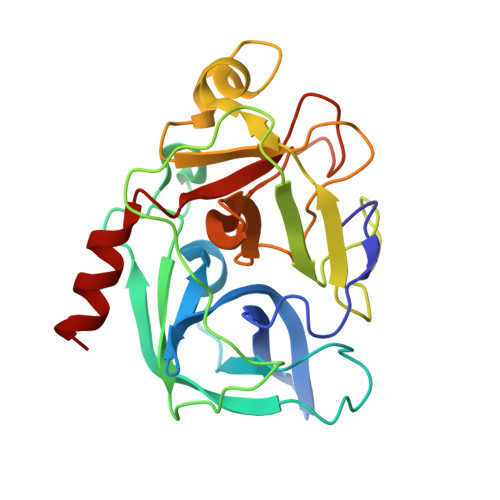X-ray-induced deterioration of disulfide bridges at atomic resolution.
Petrova, T., Ginell, S., Mitschler, A., Kim, Y., Lunin, V.Y., Joachimiak, G., Cousido-Siah, A., Hazemann, I., Podjarny, A., Lazarski, K., Joachimiak, A.(2010) Acta Crystallogr D Biol Crystallogr 66: 1075-1091
- PubMed: 20944241
- DOI: https://doi.org/10.1107/S0907444910033986
- Primary Citation of Related Structures:
3MNB, 3MNC, 3MNS, 3MNX, 3MO3, 3MO6, 3MO9, 3MOC, 3MTY, 3MU0, 3MU1, 3MU4, 3MU5, 3MU8, 3ODD, 3ODF - PubMed Abstract:
Overall and site-specific X-ray-induced damage to porcine pancreatic elastase was studied at atomic resolution at temperatures of 100 and 15 K. The experiments confirmed that irradiation causes small movements of protein domains and bound water molecules in protein crystals. These structural changes occur not only at 100 K but also at temperatures as low as 15 K. An investigation of the deterioration of disulfide bridges demonstrated the following. (i) A decrease in the occupancy of S(γ) atoms and the appearance of new cysteine rotamers occur simultaneously. (ii) The occupancy decrease is observed for all S(γ) atoms, while new rotamers arise for some of the cysteine residues; the appearance of new conformations correlates with the accessibility to solvent. (iii) The sum of the occupancies of the initial and new conformations of a cysteine residue is approximately equal to the occupancy of the second cysteine residue in the bridge. (iv) The most pronounced changes occur at doses below 1.4 × 10(7) Gy, with only small changes occurring at higher doses. Comparison of the radiation-induced changes in an elastase crystal at 100 and 15 K suggested that the dose needed to induce a similar level of deterioration of the disulfide bonds and atomic displacements at 15 K to those seen at 100 K is more than two times higher.
Organizational Affiliation:
Structural Biology Center, Biosciences Division, Argonne National Laboratory, Argonne, Illinois 60439, USA.
















